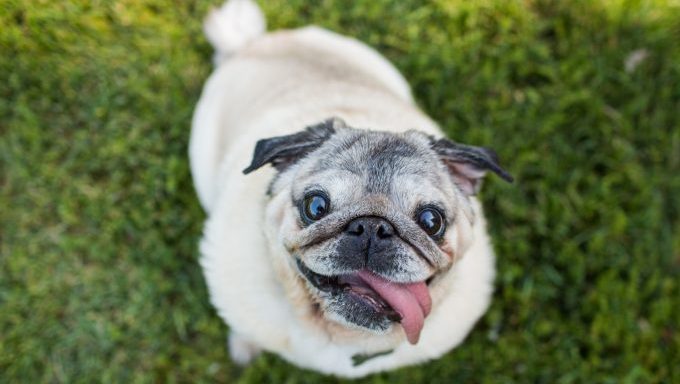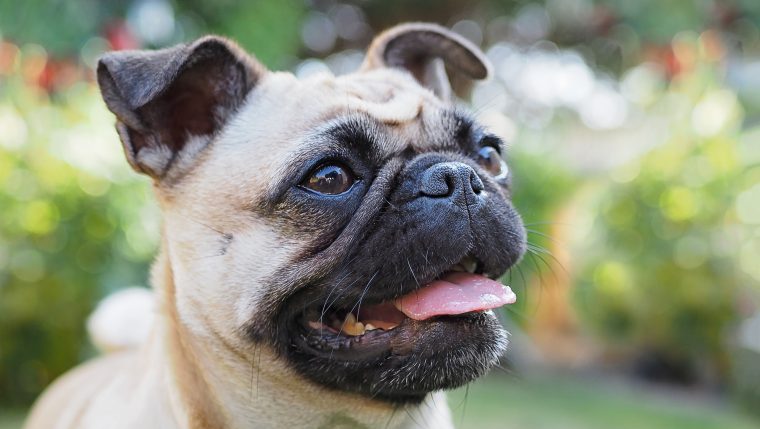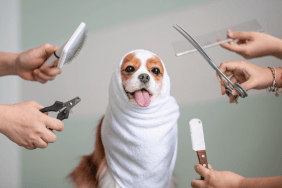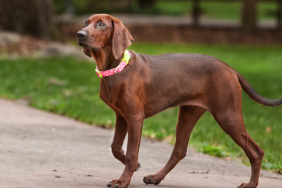
Sh0rt-faced dog breeds have become increasingly popular in recent years. Despite health concerns associated with short faces, their cute qualities win many hearts. Recently, the snub-nosed French Bulldog stole the Labrador Retriever’s status as America’s most common dog. It’s hard to deny the cuteness of many short-faced breeds, like the easygoing Pug or mischievous Boston Terrier. Some of the most popular short-faced dog breeds are also some of the most popular dog breeds overall due to their wide appeal.
What are brachycephalic dogs?
Brachycephaly is a syndrome commonly suffered by short-nosed breeds. Brachycephalic airway syndrome is a series of abnormal upper airway conditions that affect short-nosed dog breeds. For some dogs, these symptoms are mild; they may snore loudly or cough in excess. But it can also impact dogs’ ability to exercise; some dogs will breathe so heavily that they can’t play or run like an average dog. It can even cause difficulties during the most basic tasks, like eating and drinking.
What health issues do short-faced dog breeds have?
Breeding short-faced breeds altogether has become the subject of debate by dog lovers. Brachycephalic dogs face sometimes life-threatening medical conditions. Many people buy them (at exorbitant prices) thinking they’re cute, without understanding these risks. The breeders get paid, so they keep breeding, and the dogs end up at shelters when buyers can’t afford the medical costs.
Brachycephalic dogs often suffer from an elongated palate, which extends into the larynx. They also often have malformed nostrils that further prevent dogs from taking in enough air. Additionally, a brachycephalic dog can have a narrow trachea, collapsed larynx, or paralyzed cartilage in the larynx. All of these things are part of brachycephalic airway syndrome.
Pug
With so much personality packed into a small body, it’s no wonder that the Pug has remained a favorite of many families for decades. The Pug has always been bred with the intention of being a lap dog. Their clownish personalities make them entertaining companions to have around the house. In the past several decades, the Pug’s snout has gotten noticeably shorter. Pugs in the ’80s and ’90s had fewer health problems than the Pugs of today. Some breeders are trying to restore the breed’s former glory by outcrossing with other breeds to create dogs known as “Retromops” or “Retro Pugs.”
French Bulldog
Becoming America’s most popular dog breed in 2o23, you’ve likely seen Frenchies, as the breed is affectionately known by fans, just about everywhere. This short-nosed dog breed also has a huge personality. They were created in England as a miniature version of the English Bulldog. This breed has also seen many changes, with a notably shorter face than their ancestors. Besides being a lapdog, this breed also had historical use as a ratter. They’re often affable and good with just about everyone, but you should probably still keep them away from pets like hamsters due to this ongoing prey drive. However, they’re manageable for most pet parents and they make good apartment-dwelling dogs.
English Bulldog
Ancestor to the aforementioned Frenchie, the English Bulldog has also been winning hearts for centuries. Originally bred to drive cattle to market, today this breed is much more well known as a couch potato. They’re easygoing and often get along well with kids. This breed doesn’t require much exercise, and they can be perfect for working professionals. This short-faced dog breed is overall affable and willing to go with the flow.
Boston Terrier
The Boston Terrier may be small, but they’re capable of hanging with the big dogs. This feisty pup is high-energy despite their size, and they will do best with an owner that likes to engage in hands-on playtime. With that being said, their needs are fairly easy to meet, and they can still do well in an apartment environment. This breed is most commonly found in their signature black-and-white tuxedo coloration, but they can come in variants such as brindle, too.
Shih Tzu
By far the oldest dog breed on this list, the Shih Tzu was as popular during the Ming Dynasty as they are today. This short-faced dog breed originated solely to be a companion lapdog, and they’ve excelled at this purpose. This small breed requires some heavy-duty grooming, but outside of that, they need very little other than affection. A short walk and some playtime will keep this breed occupied. They’re happiest when spending time with their family members, so if you’re looking for a dog to eagerly wait for you so you can curl up on the couch together after a long day, the Shih Tzu might be a great fit.
Boxer
The only large breed on this list, the Boxer is one of America’s most beloved breeds. This breed originated with the intention of creating a dedicated guard dog. While some still keep the Boxer for this purpose, they’re more common as a family pet. Boxers aren’t known to be particularly aggressive; they’re more likely to be goofy and playful. Despite their short noses, Boxers can excel in agility and similar dog sports. They’re not likely to be a good fit as an apartment dog due to their high energy and large size.
Cavalier King Charles Spaniel
The Cavalier King Charles Spaniel may not be the easiest breed to train, but they’re endlessly loyal and kind. They retain the sporty nature of most spaniel breeds and can be a good dog to take to the agility course. While their prey drive makes them a bad fit for owners who keep small pets, they’re good pets in just about any other situation. With daily exercise and stimulation, they can easily thrive in an apartment. And they’re patient with kids, making them a popular family dog.
Do you have a short-faced dog at home? Then check out our guide to keeping brachycephalic dogs safe in the summer!









